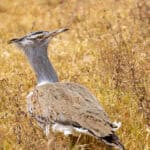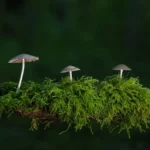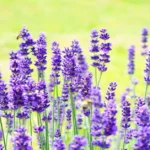The Amazon Rainforest, a vast and vibrant biome, is home to an incredible array of wildlife. Exploring the diversity of Amazon forest birds reveals the richness of this unique habitat.
Birds of all colors, shapes, and sizes inhabit the dense foliage, contributing to the forest’s beauty and ecological balance.
Bird diversity in the Amazon is crucial for maintaining the ecosystem. These birds play vital roles in pollination, seed dispersal, and controlling insect populations. Their presence indicates a healthy, thriving environment, essential for the forest and the planet.
In this blog post, we will delve into the richness of Amazonian birdlife, highlight notable species, and discuss their roles in the ecosystem. We’ll also cover current conservation efforts to protect these incredible birds.
The Richness of Amazonian Birdlife
The Amazon Rainforest, spanning nine countries in South America, is the world’s largest tropical rainforest. Covering over 2.1 million square miles, it provides a lush and expansive habitat for countless species.
This vast biome includes parts of Brazil, Peru, Colombia, and six other nations, creating a diverse and rich environment for wildlife.
The diversity of Amazon Forest birds is astounding, with over 1,300 species recorded. These birds range from the vibrant macaws and toucans to the elusive harpy eagle.
The rainforest’s dense canopy, riverbanks, and forest floor offer unique habitats, supporting a wide variety of birdlife. This incredible diversity makes the Amazon a crucial area for avian biodiversity.
The Amazon Rainforest is vital as a habitat for these birds. Its rich plant life provides food and shelter, essential for bird survival. Birds, in turn, help maintain the forest by pollinating plants and dispersing seeds.
This interdependence highlights the importance of preserving the Amazon, ensuring that the diversity of Amazon forest birds continues to thrive.
Notable Bird Species of the Amazon Rainforest
Notable birds species found in Amazon forest include:
Harpy Eagle
The Harpy Eagle is one of the most powerful and majestic birds in the Amazon Rainforest. It stands out with its impressive size, reaching up to 40 inches in height, with a wingspan of over seven feet.
Its striking features include large, curved talons and a crown of feathers on its head, which gives it a fierce and regal appearance. The Harpy Eagle’s plumage is a mix of gray, black, and white, making it a truly distinctive bird.
Harpy Eagles prefer to live in tall, dense forests where they can find their primary prey—large mammals like monkeys and sloths. They are skilled hunters, using their powerful talons to snatch prey from trees with incredible precision.
These eagles are mostly solitary and very territorial, often staying within a defined area that they fiercely defend. Their presence in the rainforest is a sign of a healthy ecosystem, highlighting the importance of conserving their habitat.
Toco Toucan
The Toco Toucan is one of the most recognizable birds in the Amazon Rainforest, primarily due to its large, colorful bill. The bill, which can be up to 7.5 inches long, is orange with a black tip.
This bird’s plumage is mostly black, with a white throat and chest, and bright blue rings around its eyes. Despite its large bill, the Toco Toucan is lightweight and agile.
Toco Toucans are commonly found in the canopy of the rainforest, where they live in small flocks. They feed on a diet of fruits, insects, and small reptiles. The large bill is not only a tool for feeding but also for regulating their body temperature.
Toco Toucans play an important role in seed dispersal, helping to maintain the diversity of the forest’s plant life. Their distinctive calls are a common sound in the Amazon, adding to the rich tapestry of the rainforest’s biodiversity.
Amazonian Royal Flycatcher
The Amazonian Royal Flycatcher is a small, colorful bird known for its striking crest. When raised, the crest displays an array of vibrant colors, ranging from red to yellow with black and blue markings.
The bird itself is about 6.5 inches long, with olive-brown upperparts and yellowish underparts, making it well-camouflaged when its crest is not displayed.
Amazonian Royal Flycatchers live in the lower and middle levels of the forest, often near streams and rivers. They are insectivores, catching insects in mid-air with their agile flying skills.
These birds are generally solitary or found in pairs, and they are known for their elaborate courtship displays. Their presence indicates a healthy insect population, contributing to the balance of the ecosystem.
King Vulture
The King Vulture is one of the most striking scavengers in the Amazon Rainforest. It is known for its bright and colorful head, which features shades of orange, yellow, and red.
Its body is predominantly white with contrasting black wings and tail. This large bird can have a wingspan of up to seven feet, making it an impressive sight in the sky.
King Vultures inhabit tropical lowland forests, savannas, and grasslands. They play a crucial role in the ecosystem by feeding on carrion, helping to clean up dead animals and prevent the spread of disease.
Unlike other vultures, they have a strong beak capable of tearing through tough hides. These birds are generally solitary but can be seen congregating at large carcasses.
Also Read: A Guide to the Different Forest Types Found in India
Scarlet Macaw
The Scarlet Macaw is one of the most iconic birds in the Amazon Rainforest. Known for its bright red feathers, the Scarlet Macaw also features blue and yellow on its wings and tail. This colorful plumage makes it easily recognizable and highly admired.
These birds can reach up to 32 inches in length and have strong, curved beaks that help them crack open hard nuts and seeds.
Scarlet Macaws live in the canopy and edges of the Amazon Rainforest. They are social birds, often seen in pairs or small flocks. Their loud, squawking calls can be heard from a distance, making them easy to locate.
They feed on a variety of fruits, nuts, and seeds, playing a key role in seed dispersal, which helps maintain the health of the forest.

Blue-and-Yellow Macaw
The Blue-and-Yellow Macaw, also known as the Blue-and-Gold Macaw, is another striking bird of the Amazon. It is easily identified by its vibrant blue wings and tail, contrasting with a bright yellow chest and underparts.
These macaws can grow up to 34 inches in length and are known for their strong, large beaks, which they use to crack nuts and seeds.
Blue-and-Yellow Macaws inhabit forests and swamps throughout the Amazon. They are often seen in pairs or small groups and are known for their loud, distinctive calls.
These birds are strong fliers and can travel long distances in search of food. Their diet consists mainly of fruits, nuts, and seeds, which they help disperse across the forest, contributing to the ecosystem’s regeneration.
Wire-tailed Manakin
The Wire-tailed Manakin is a small, vividly colored bird found in the Amazon. Males are particularly striking with bright red heads, yellow bellies, and green backs, while their tails feature long, thin wire-like extensions.
Females are more subdued, with green plumage that provides excellent camouflage in the forest.
Wire-tailed Manakins inhabit the understory of tropical forests, where they are known for their fascinating courtship dances. Males gather in leks to perform synchronized displays, hopping and darting around to attract females.
These birds feed on fruits and insects, playing a role in seed dispersal and insect population control. Their elaborate mating rituals and colorful appearance make them a fascinating subject for birdwatchers and researchers alike.
Capped Heron
The Capped Heron is a striking bird with a distinctive appearance. It has a white body, a blue face, and a unique black cap on its head.
The bird’s bill is long and pointed, ideal for catching fish. Capped Herons are about 20 inches tall and have elegant, slender legs.
Capped Herons are typically found near water bodies such as rivers, lakes, and swamps in the Amazon. They are solitary hunters, stalking their prey slowly and using their sharp bills to catch fish, frogs, and insects.
Their presence indicates healthy aquatic ecosystems, as they rely on abundant and clean water sources for their food. The Capped Heron’s striking appearance and solitary behavior make it a captivating bird to observe in the wild.
Fiery Topaz
The Fiery Topaz is an exquisite hummingbird found in the Amazon. Males are known for their iridescent orange-red throats and vibrant green bodies, while females have a more muted green and white appearance.
These tiny birds are about 4 inches long and are among the most colorful hummingbirds in the region.
Fiery Topazes prefer habitats near rivers and streams, where they can find abundant flowers for nectar. They are agile fliers, capable of hovering and making rapid aerial maneuvers to catch insects.
These hummingbirds play a critical role in pollination, helping many plants reproduce. Their brilliant colors and energetic behavior make them a joy to observe in the wild.
Hoatzin
The Hoatzin is a unique and ancient bird found in the Amazon Rainforest. Its most notable feature is its chick’s claws on their wings, a trait reminiscent of early birds from prehistoric times.
Adult Hoatzins are about 26 inches long and have a striking appearance with a spiky crest of feathers on their heads, red eyes, and blue facial skin. Their plumage is a mix of brown, rust, and white, making them easily recognizable.
Hoatzins inhabit swamps, riverbanks, and dense vegetation near water. They are herbivores, primarily eating leaves and buds, which they ferment in their enlarged crop, giving them a distinctive, pungent odor.
These birds are poor fliers, often seen clambering clumsily through branches. They are social birds, living in small family groups, and their unusual digestive system plays a unique role in their ecosystem.

Great Potoo
The Great Potoo is a master of camouflage in the Amazon Rainforest. It has mottled gray and brown plumage that allows it to blend seamlessly with tree bark.
This nocturnal bird has large, round eyes adapted for night vision and a wide, gaping mouth used to catch insects mid-flight. It is about 18 inches long, making it one of the larger members of the potoo family.
Great Potoos are found in lowland forests and woodland edges. They are known for their eerie, haunting calls that can be heard during the night.
During the day, they perch motionless on tree branches, relying on their camouflage to remain undetected. These birds are solitary and highly territorial, with a preference for high vantage points where they can observe their surroundings.
Collared Aracari
The Collared Aracari is a colorful and social bird found in the Amazon. It has a striking appearance with a black head, a red band around its neck, and a bright yellow belly.
Its long, curved beak is orange and black, adding to its distinctive look. These birds are about 16 inches long and are part of the toucan family.
Collared Aracaris live in small flocks and are often seen hopping through the canopy in search of food. They primarily eat fruits but will also consume insects and small vertebrates.
Their social nature is evident in their cooperative behavior, as they often share food and roost together in tree cavities. Their diet helps in seed dispersal, contributing to forest regeneration.
Black-capped Donacobius
The Black-capped Donacobius is a lively bird with striking black and orange plumage. It has a black head, white throat, and bright orange underparts.
Its long tail and loud, musical calls make it easy to spot and hear in its habitat. These birds are about 9 inches long and are known for their energetic behavior.
Black-capped Donacobius birds are typically found in wetlands, marshes, and along riverbanks. They are often seen in pairs or small family groups, engaging in constant vocal communication.
Their diet consists of insects and small invertebrates, which they forage for in dense vegetation. These birds are highly territorial and will defend their nesting areas vigorously.
Festive Amazon
The Festive Amazon is a vibrant parrot species found in the Amazon Rainforest. It has a predominantly green body with splashes of red on its wings and a distinctive blue crown.
These birds can grow up to 14 inches long and are known for their bright, festive plumage, which gives them their name.
Festive Amazons inhabit tropical forests and woodlands, often near rivers. They are social birds, typically seen in pairs or small flocks. Their diet includes fruits, seeds, and nuts, which they crack open with their strong beaks.
These parrots are known for their loud, raucous calls and their ability to mimic sounds. Their social and vocal nature makes them a lively presence in the rainforest.
Pompadour Cotinga
The Pompadour Cotinga is a striking bird known for its vibrant plumage. Males have bright crimson feathers and a glossy appearance, while females are more subdued with brown and white coloration.
This sexual dimorphism is common among many bird species, where males have more vivid colors to attract mates.
Pompadour Cotingas inhabit the canopy of the Amazon Rainforest, where they feed primarily on fruits. They are often seen alone or in small groups, flitting through the treetops.
Their diet helps in seed dispersal, making them important for the regeneration of the forest. These birds are relatively elusive, and their bright plumage can be challenging to spot against the dense foliage.

Crimson Topaz
The Crimson Topaz is a dazzling hummingbird with iridescent plumage. Males are particularly striking with brilliant red throats, green crowns, and golden tails.
Females are less vibrant, displaying a mix of green and white feathers. These small birds are about 8 inches long, including their long tail feathers.
Crimson Topazes are found near forest edges, rivers, and clearings within the Amazon. They are known for their agile flight and rapid wing beats, allowing them to hover as they feed on nectar.
In addition to nectar, they consume insects for protein. Their role as pollinators is crucial, as they help fertilize many flowering plants in the rainforest.
Spangled Cotinga
The Spangled Cotinga is one of the most visually stunning birds in the Amazon. Males exhibit a bright turquoise-blue color with black wings and tails, while females are a more subdued brown.
This striking contrast makes the males highly noticeable during mating displays.
Spangled Cotingas inhabit the upper canopy of the rainforest, where they feed mainly on fruits and insects. These birds are solitary and often perch high in the trees, surveying their surroundings.
Their vibrant colors make them a favorite among bird watchers, and their feeding habits aid in seed dispersal, contributing to forest health.
Red-and-Green Macaw
The Red-and-Green Macaw is a large, colorful parrot native to the Amazon. It has bright red plumage on its head and shoulders, with green wings and a blue tail.
These macaws can reach up to 35 inches in length, making them one of the largest parrot species.
Red-and-Green Macaws inhabit the lowland rainforests, often near rivers and clay licks. They feed on a diet of fruits, nuts, and seeds, using their strong beaks to crack open hard shells.
These birds are known for their loud, raucous calls and strong pair bonds, often seen flying in pairs or small groups. Their social nature and striking appearance make them a highlight of the Amazonian bird community.
Yellow-Rumped Cacique
The Yellow-rumped Cacique is a vibrant bird with glossy black plumage and a distinctive yellow patch on its lower back.
They also have bright yellow eyes and a long, pointed bill. These birds are about 10 inches long and are known for their striking coloration and vocal abilities.
Yellow-rumped Caciques live in colonies in the Amazon Rainforest, often building their nests in large, communal trees. They are highly social and cooperative, with complex social structures within their colonies.
These birds feed on fruits, insects, and small vertebrates, contributing to the balance of the ecosystem. Their loud calls and complex songs are a common sound in their habitat.
Rufous-bellied Thrush
The Rufous-bellied Thrush is a medium-sized bird with a distinctive orange-rust colored belly and olive-brown upperparts.
It is about 10 inches long and has a melodious song, often heard in the early morning and late afternoon. This thrush is the national bird of Brazil, symbolizing the country’s rich biodiversity.
Rufous-bellied Thrushes are adaptable birds, found in a variety of habitats including forests, gardens, and urban areas. They are omnivores, feeding on fruits, insects, and small invertebrates.
These birds are known for their territorial behavior, often seen chasing away other birds from their feeding grounds. Their presence in diverse habitats showcases their adaptability and importance in various ecosystems.

The Role of Birds in the Amazon Ecosystem
Birds play a crucial role in the Amazon ecosystem, contributing significantly to its health and stability.
They are involved in various ecological processes, including seed dispersal and pollination, which help maintain the diversity and structure of the rainforest.
By transporting seeds over long distances, birds facilitate the growth of new plants and trees, ensuring the regeneration of the forest.
This seed dispersal is vital for many plant species that rely on birds to reproduce and spread.
Additionally, birds act as pollinators, aiding in the reproduction of flowering plants. Their movements from flower to flower transfer pollen, enabling the plants to produce fruits and seeds.
Birds also serve as indicators of ecosystem health. Changes in bird populations can signal shifts in environmental conditions, such as habitat loss or climate change.
Monitoring these changes helps scientists understand the impacts on the ecosystem and develop strategies to protect and preserve the Amazon Rainforest.
Conservation Efforts
Amazonian birds face numerous threats, including deforestation, habitat fragmentation, and climate change. The rapid destruction of the Amazon Rainforest for agriculture, logging, and mining significantly reduces the habitat available for birds.
This loss of habitat disrupts their feeding, breeding, and migration patterns, putting many species at risk. Additionally, illegal wildlife trade and pollution further endanger these birds, making conservation efforts more critical than ever.
Several conservation initiatives aim to protect Amazonian birds and their habitats. For example, the Rainforest Trust works to create protected areas and reserves in the Amazon.
By collaborating with local communities and governments, they help safeguard critical habitats and ensure sustainable land use.
One of their successful projects includes the establishment of the Alto Mayo Protected Forest in Peru, which protects numerous bird species and other wildlife.
Readers can contribute to conservation efforts in various ways. Supporting organizations like the Rainforest Trust through donations or volunteering can make a significant impact.
Additionally, adopting sustainable lifestyle choices, such as reducing meat consumption and avoiding products linked to deforestation, can help protect the Amazon.
Educating others about the importance of the rainforest and advocating for policies that prioritize conservation are also powerful ways to contribute.
Conclusion
The Amazon Rainforest is home to an incredible array of bird species, each playing a vital role in maintaining the ecosystem’s health. The diversity of Amazon Forest birds highlights the rich biodiversity of this region.
These birds contribute to seed dispersal, pollination, and serve as indicators of the ecosystem’s well-being.
Preserving these species and their habitats is crucial for the overall health of the rainforest. Protecting the diverse bird population ensures the continuation of these essential ecological processes.
Conservation efforts are vital to safeguard these birds from threats such as deforestation and climate change.
By supporting conservation initiatives and adopting sustainable practices, we can help protect the Amazon Forest birds for future generations. Together, we can make a difference in preserving this vital part of our planet’s biodiversity.








